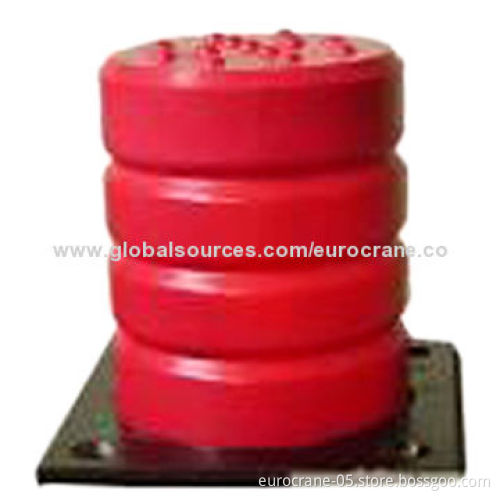
Polyurethane Buffer, Easy to Maintain
- Payment Type:
- L/C, T/T
Quantity:
Your message must be between 20 to 2000 characters
Contact NowBasic Info
Basic Info
| Payment Type: | L/C, T/T |
|---|
Product Description
Product Description
- Advantages:
- Lightweight design
- Ease to maintain and repair
- Resistant to corrosion, impact and stress
- Generate neither noise nor sparks during operation, thus suitable for use in explosive atmosphere
- Specifications:
- Crane buffer density: 0.55 to 0.65
- Shore hardness: 50 to 65
- Compressive strength (50% compression): 12 to 15kg/cm2
- Operating temperature: -30 to 60°C
- Advantages:
- With increase in extent of compression, number of holes that allow fluid to pass through will be reduced to ensure uniform speed at which buffering process carried out
- Despite its compact design, able to absorb large amount of energy
- Enables maximum deceleration of running crane or trolley while coming in minimum size
- For cranes with high mass or speed exceeding of 2m/second
- Technical features:
- Absorbs 80 to 100% of energy produced in impact shock
- Angle of deflection after collision is controlled within range between 0 and 1
- Operating temperature: -25 to 80°C
- Suitable for use on heavy-duty cranes or in special applications
- Lightweight design
- Ease to maintain and repair
- Resistant to corrosion, impact and stress
- Generate neither noise nor sparks during operation, thus suitable for use in explosive atmosphere
- Crane buffer density: 0.55 to 0.65
- Shore hardness: 50 to 65
- Compressive strength (50% compression): 12 to 15kg/cm2
- Operating temperature: -30 to 60°C
- With increase in extent of compression, number of holes that allow fluid to pass through will be reduced to ensure uniform speed at which buffering process carried out
- Despite its compact design, able to absorb large amount of energy
- Enables maximum deceleration of running crane or trolley while coming in minimum size
- For cranes with high mass or speed exceeding of 2m/second
- Absorbs 80 to 100% of energy produced in impact shock
- Angle of deflection after collision is controlled within range between 0 and 1
- Operating temperature: -25 to 80°C
- Suitable for use on heavy-duty cranes or in special applications
Related Keywords
Related Keywords













